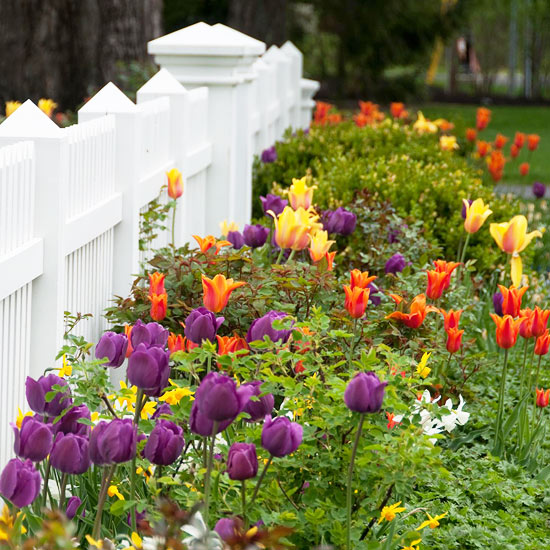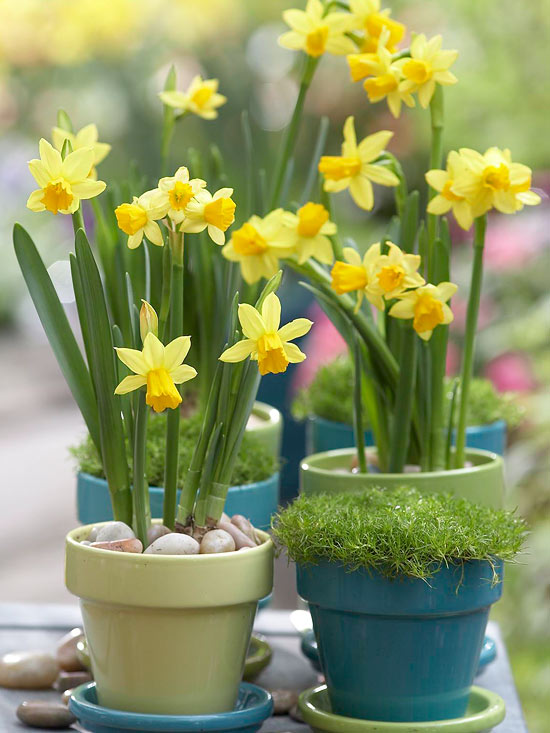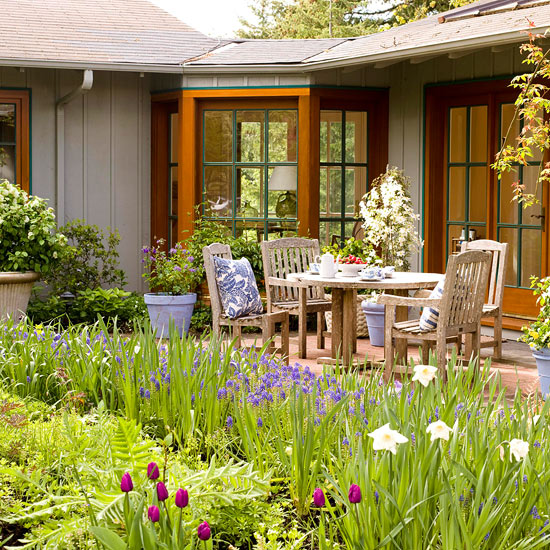





Daffodils look cheery, hyacinths smell divine, and crocuses pop up early, but something about a bright, cup-shape tulip inspires true spring joy. Unfortunately, this joy can be cut short unless you take a few precautions to protect your bulbs. Use these 10 tips to ensure a bountiful tulip display.
continue reading below
Tulips in a landscape provide a salad bar for deer. The most effective protection from deer is a fence. Install one that's at least 8 feet tall or two fences 4 feet tall and 4 feet apart. Deer can jump high or wide, but they can't do both at once.
Get more tips for deterring deer.
To foil groundhogs and other burrowing critters, a fence that's 3 feet tall and 10-12 inches below ground (to prevent them from digging under the fence) is an effective deterrent.
Squirrels and mice seem to take special pleasure in finding, digging, and nibbling tulip bulbs. Wide wire mesh, such as chicken wire, is an effective deterrent. Lay it directly on top of the bed, extending the surface about 3 feet from the plantings, then stake it down.
You can also plant bulbs in wire cages. Place the bulbs in the center of the cage and fill the edges with dirt so critters can't gnaw around the edges.
Some gardeners place an old window screen on top of the ground to deter squirrels. Remove it once the ground freezes because tulip plants can't grow through the screening material as they can with chicken wire.
Plant tulip bulbs deep, at least three times the height of the bulb, and cover bulbs properly with soil so critters aren't attracted to the planting site. Some gardeners claim that planting a bit deeper enhances hardiness and makes it harder for digging pests to find tulip bulbs. Always remove all evidence of bulb planting, including any dried bulb casings, from the area so the scent doesn't attract predators.
Watch video tips for bulb planting.
Mulching bulbs is a great idea to conserve soil moisture and maintain a cool soil temperature. Just don't apply it too soon. Mulching when it's still warm provides a cozy place for critters to burrow in for the winter, and it may inspire them to dig into your bulbs. Wait until the ground is cold or frozen. Mulch helps keep soil temperatures consistently cool and will minimize damage from frost heaving.
More on mulch!

Tulips need about 12 weeks of cold chilling to bloom properly, but there is a risk of freezing when bulbs are planted in pots left outdoors. Use a freeze-proof pot at least the size of a half-whiskey barrel to provide enough protection. Place it in a protected area, such as inside a garage or near a house foundation, until the bulbs sprout in spring. You can also group large pots in a protected area and wrap them with burlap or other insulating material.
Get a chilling time chart for bulbs.
Tulip bulbs are native to dry Mediterranean climates and need excellent drainage to thrive. Planting in clay or other waterlogged soils suffocates the bulbs because there are no air spaces that allow roots to grow. Wet soil also promotes fungus and diseases.
Add compost and coarse builder's sand (not playground sand) to soil to promote good drainage. Planting in raised beds with amended soils may be the best solution in areas with dense soil.
Get bulb planting tips.

Commercial pest repellent products fill garden center shelves. Some might work in your yard -- for a while. Deer, rabbits, rodents, and other critters often become so used to the repellent that it is no longer effective. Many are scent-based products that wear off after rain so they must be reapplied frequently. And remember, what works in one garden doesn't always work in another.
Folk remedies include hanging Irish Spring soap from mesh bags, scattering human hair clippings, sprinkling predator urine, dusting with cayenne or crushed red pepper, and spraying rotten egg mixtures around the garden perimeter. Again, the success of these remedies might vary.
According to TulipWorld, an online bulb company, a favorite Dutch remedy to foil predators is to interplant tulips with crown imperial (Fritillaria imperialis). This tall, dramatic plant emits an odor that repels critters.
Learn more about crown imperial.
Critters also avoid alliums and daffodils, so interplanting with those bulbs may help protect tulip bulbs.
Check out these pest-resistant bulbs.
Talk about a government handout! Gardeners at the White House in Washington, D.C., where tulip beds were routinely pillaged by marauding squirrels, decided to hang peanut-filled boxes in nearby trees. The squirrel-feeding program, in effect from fall planting time until bloom time, cut the bulb losses -- although some squirrels still helped themselves to the tulip bulbs. The gardeners also acknowledged that the peanuts might have attracted more squirrels to the grounds.
Copyright © www.100flowers.win Botanic Garden All Rights Reserved